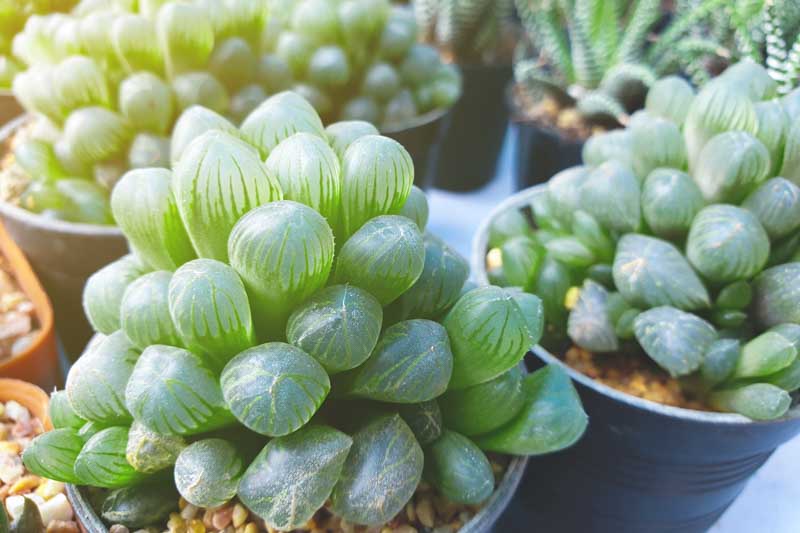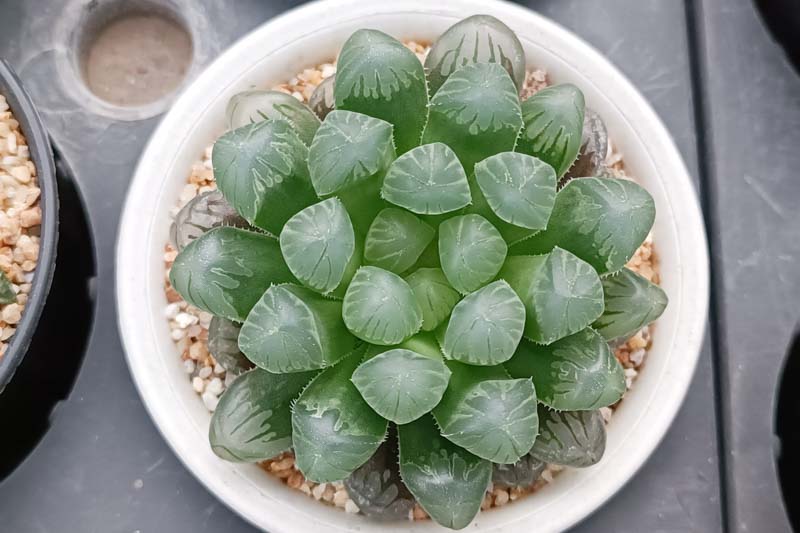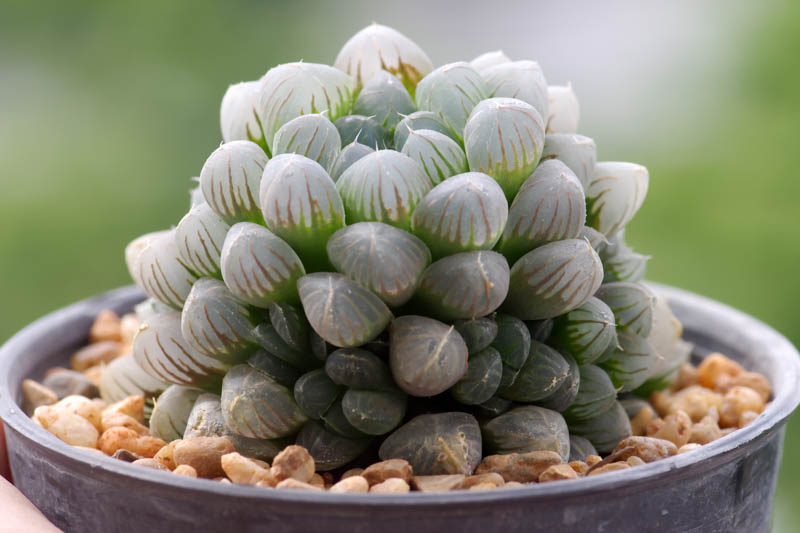Bristle Haworthia, Cooper's Haworthia, Pussy Foot, Window Haworthia
Haworthia cooperi is a distinctive and fascinating succulent, beloved by enthusiasts for its unique, almost transparent leaves. It thrives in partial shade or filtered sunlight, making it an ideal houseplant.
Haworthia cooperi features small, rosette-forming succulents with fleshy, translucent leaves that can appear almost glass-like. The leaves are usually green but can have a bluish or purplish hue under certain conditions.
Native: It originates from South Africa, where it grows in well-drained soil among rocky outcroppings, often under the partial shade of other vegetation. Haworthia cooperi belongs to the Asphodelaceae family along with Aloe, Eremurus (Foxtail Lily), and Hemerocallis (Daylily).
Plant Type and Habit: This slow-growing succulent grows in tight rosettes. Its compact size and slow growth rate make it perfect for small spaces.
Size: Mature plants typically grow 2 to 4 inches (5-10 cm) tall and have a similar spread.
Flowers: Haworthia cooperi blooms with small, white to pinkish-white flowers on thin, long stems that can extend 16 inches (40 cm) above the foliage in spring or summer.
Foliage: The most striking feature of Haworthia cooperi is its plump, almost entirely transparent leaves, up to 2 inches long (5 cm), that allow light to pass through, highlighting the intricate internal leaf structures. Leaves may be triangular or rounded with bristly margins and keels.
Hardiness: It is hardy in USDA zones 9 to 11 and is commonly grown as a houseplant in cooler climates.
Uses: Its unique appearance makes it a popular choice for indoor succulent collections, terrariums, and as a desktop plant.
Toxicity: Haworthia cooperi is generally considered non-toxic to pets and humans, making it a safe choice for households with animals.
Drought: Like most succulents, Haworthia cooperi is highly drought-tolerant once established, requiring minimal watering.
Invasiveness: This plant is not invasive and is well-contained within its growing area, making it a responsible choice for gardens and indoor settings.
Benefits: Its ease of care, unique translucent foliage, and non-toxic properties make it a delightful addition to any indoor plant collection.

Growing and caring for Haworthia cooperi, both indoors and outdoors, requires attention to a few specific conditions to ensure its thriving growth and the maintenance of its distinctive striped leaves.
Light: Haworthia cooperi thrives in bright, indirect light. Place it near a window where it can receive ample light but is shielded from the harsh midday sun, which can scorch its leaves. A north or east-facing window is ideal.
Water: Water sparingly, only when the soil has completely dried out. This plant is drought-tolerant and prone to root rot if overwatered. Reduce watering in the winter months when the plant is not actively growing.
Soil: Use a well-draining cactus or succulent mix to ensure excess water can easily escape, preventing root rot.
Temperature: It prefers average indoor temperatures, between 60-80°F (15-27°C). Avoid placing it in drafty areas or near heat sources.
Humidity: Haworthia cooperi tolerates average indoor humidity levels. There’s no need for additional humidity.
Feeding: Feed with a diluted succulent fertilizer once or twice during the spring and summer growing seasons. Do not fertilize in the winter.
Light: In outdoor settings, provide partial shade or filtered sunlight, especially in hotter climates, to prevent sunburn.
Water: Outdoor plants may require more frequent watering than indoor ones, especially in warmer months. However, allow the soil to dry out between watering sessions.
Soil: Plant in a well-draining succulent mix if in pots, or amend garden soil with sand or perlite to improve drainage.
Temperature: Haworthia cooperi can be grown outdoors year-round in USDA zones 9 to 11. In cooler zones, bring it indoors before the first frost.
Placement: In gardens, they make excellent ground cover in rock gardens or succulent beds. Ensure they’re placed where they won’t be waterlogged.

Propagating Haworthia cooperi is a straightforward process that can be accomplished through offsets or leaf cuttings. Here’s how to do it:
Identify Offsets: Look for small rosettes forming at the base of the parent plant. These offsets are the easiest and most successful way to propagate Haworthia cooperi.
Separation: Wait until the offset has formed its own roots before gently removing it from the parent plant. You can do this by carefully pulling the offset away from the main plant or using a clean, sharp knife to cut it off, ensuring you include some roots.
Allow to Dry: Let the offset sit in a warm, dry place for a few days to allow the cut area to callous over. This helps prevent rot when planted.
Planting: Plant the offset in a pot filled with a well-draining succulent or cactus mix. The pot should have drainage holes at the bottom.
Care After Planting: Water lightly and place the pot in bright, indirect light. Keep the soil lightly moist but not waterlogged as the offset establishes.
Leaf Selection: Choose a healthy, full-grown leaf from the outer part of the rosette.
Remove the Leaf: Gently twist the leaf from the plant. Ensure a clean break at the base to include a bit of the stem, if possible, which increases the chances of successful propagation.
Drying: Allow the leaf to dry for a few days until the cut end callouses over.
Planting: Place the calloused end into a pot with a well-draining soil mix, ensuring the leaf is upright.
Care: Water sparingly to avoid rotting the leaf before it has a chance to root. Keep in a place with bright, indirect light.
Propagation can also be done through seeds, but this method is less common due to the slower growth and more care required for seedlings. Offsets and leaf cuttings provide a quicker and more reliable result, making them the preferred methods for most enthusiasts.

Haworthia cooperi is generally easy to care for, but like all plants, it can encounter pests, diseases, and common problems.
Mealybugs: These tiny, white, cottony pests tend to hide in the crevices of the plant, sucking sap and weakening it. Treat by dabbing the pests with a cotton swab dipped in rubbing alcohol or applying neem oil.
Spider mites: Indicated by fine webbing on the plant, these pests thrive in dry conditions. Increase humidity around the plant and rinse it off with water. Neem oil can also be effective.
Aphids: Small and typically found on new growth. They can be washed off with a strong jet of water or treated with neem oil.
Fungus gnats: Overwatering can lead to fungus gnat problems, as these pests are attracted to moist soil. Reducing watering and allowing the soil to dry out can help prevent them.
Root rot: The most common issue, typically due to overwatering. Ensure the soil is well-draining and allow it to dry out completely between waterings.
Fungal Infections: Overly moist conditions can lead to fungal diseases. Avoid getting water on the leaves when watering and ensure good air circulation around the plant.
Leaf Translucency: While Haworthia cooperi leaves are naturally somewhat translucent, excessive sunlight can cause the leaves to turn yellow or red, indicating stress.
Shriveled Leaves: Underwatering or root damage can lead to shriveled leaves. Ensure a consistent watering schedule, allowing the soil to dry out between waterings.
Lack of Growth: Insufficient light can slow down growth. While Haworthia cooperi can tolerate low light, it thrives in bright, indirect light.

Haworthia cooperi prefers bright, indirect light and can be sensitive to direct sunlight. Extended exposure to direct sun can cause the leaves to scorch or turn red, indicating stress. A location with filtered sunlight, such as behind a sheer curtain, is ideal.
Haworthia cooperi is primarily used as an ornamental plant. Its unique, translucent leaves make it a popular choice for indoor gardens, terrariums, and as a desk plant. It’s also appreciated by succulent collectors for its aesthetic appeal and ease of care.
Water Haworthia cooperi sparingly, allowing the soil to completely dry out between waterings. In general, this might mean watering every 2-3 weeks during the growing season (spring and summer) and reducing watering frequency in the fall and winter to once a month or less, depending on environmental conditions.
Haworthia cooperi is native to the Eastern Cape of South Africa and thrives in a climate that is mostly dry with occasional rain. It prefers temperatures that are warm but can tolerate cooler temperatures at night. Indoors, it enjoys typical room temperatures, between 60°F to 80°F (15°C to 27°C).
Haworthia cooperi can tolerate temperatures as low as 50°F (10°C) for short periods, but prolonged exposure to cold can damage the plant. It is not frost-tolerant and should be kept indoors or in a greenhouse in regions that experience freezing temperatures.
| Hardiness |
9 - 11 |
|---|---|
| Heat Zones |
10 - 12 |
| Climate Zones | 15, 16, 17, 20, 21, 22, 23, 24 |
| Plant Type | Houseplants, Cactus & Succulents |
| Plant Family | Asphodelaceae |
| Genus | Haworthia |
| Exposure | Full Sun, Partial Sun |
| Season of Interest |
Spring (Early, Mid, Late) Summer (Early, Mid, Late) Fall Winter |
| Height |
2" - 4" (5cm - 10cm) |
| Spread |
2" - 4" (5cm - 10cm) |
| Spacing |
2" - 4" (5cm - 10cm) |
| Maintenance | Low |
| Water Needs | Low |
| Soil Type | Loam, Sand |
| Soil pH | Alkaline, Neutral |
| Soil Drainage | Well-Drained |
| Characteristics | Showy, Evergreen |
| Tolerance | Drought |
| Garden Uses | Patio And Containers |
| Hardiness |
9 - 11 |
|---|---|
| Heat Zones |
10 - 12 |
| Climate Zones | 15, 16, 17, 20, 21, 22, 23, 24 |
| Plant Type | Houseplants, Cactus & Succulents |
| Plant Family | Asphodelaceae |
| Genus | Haworthia |
| Exposure | Full Sun, Partial Sun |
| Season of Interest |
Spring (Early, Mid, Late) Summer (Early, Mid, Late) Fall Winter |
| Height |
2" - 4" (5cm - 10cm) |
| Spread |
2" - 4" (5cm - 10cm) |
| Spacing |
2" - 4" (5cm - 10cm) |
| Maintenance | Low |
| Water Needs | Low |
| Soil Type | Loam, Sand |
| Soil pH | Alkaline, Neutral |
| Soil Drainage | Well-Drained |
| Characteristics | Showy, Evergreen |
| Tolerance | Drought |
| Garden Uses | Patio And Containers |
How many Haworthia cooperi (Cooper’s Haworthia) do I need for my garden?
| Plant | Quantity | |
|---|---|---|
| Haworthia cooperi (Cooper’s Haworthia) | N/A | Buy Plants |
Create a membership account to save your garden designs and to view them on any device.
Becoming a contributing member of Gardenia is easy and can be done in just a few minutes. If you provide us with your name, email address and the payment of a modest $25 annual membership fee, you will become a full member, enabling you to design and save up to 25 of your garden design ideas.
Join now and start creating your dream garden!
Create a membership account to save your garden designs and to view them on any device.
Becoming a contributing member of Gardenia is easy and can be done in just a few minutes. If you provide us with your name, email address and the payment of a modest $25 annual membership fee, you will become a full member, enabling you to design and save up to 25 of your garden design ideas.
Join now and start creating your dream garden!